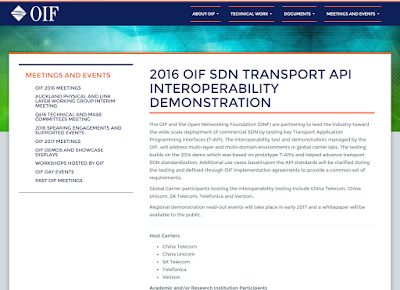The Optical Internetworking Forum (OIF), in partnership with the Open Networking Foundation (ONF), will host a global Software-Defined Networking (SDN) Transport Application Programming Interface (T-API) interoperability demonstration in the fall of 2016.
OIF said that one main focus of the global demonstration is the notification interface – the means for notifying applications that congestion is being observed, triggering moving around of traffic and addition of capacity. Additional use cases based upon the API standards will be clarified during the testing and defined through OIF implementation agreements to provide a common set of requirements.
Host carriers for the demonstration include China Telecom, China Unicom, SK Telecom, Telefónica and Verizon.
Participating vendors include ADVA Optical Networking, Ciena, Coriant, Fiberhome, Huawei Technologies Co., Ltd., Juniper Networks, NEC Corporation, Sedona Systems, SM Optics and ZTE.
 Consulting carriers include Orange and TELUS. Academic and/or research institution participants include China Academy of Telecommunication Research (CATR) and Centre Tecnològic de Telecomunicacions de Catalunya (CTTC).
Consulting carriers include Orange and TELUS. Academic and/or research institution participants include China Academy of Telecommunication Research (CATR) and Centre Tecnològic de Telecomunicacions de Catalunya (CTTC).
“In the modern operating environment, carriers need to dynamically move capacity to handle quickly changing traffic demands,” said Jonathan Sadler of Coriant and the OIF’s technical committee vice chair and acting networking interoperability chair. “The APIs that are being tested create a new breed of applications. Like so many of the interoperability agreements developed by the OIF, demand from carriers continues to drive the technical direction of the Forum.”
“ONF and the OIF are united in our goal of moving these technical advances into the market for the benefit of network operators and their users,” said Dan Pitt, executive director of the Open Networking Foundation. “We are pleased to extend our longstanding collaboration with the OIF on T-API, leveraging OIF’s specialized optical expertise, and these demonstrations inspire operators and vendors alike to accelerate development and deployment.”
http://www.oiforum.com/meetings-and-events/2016-oif-sdn-t-api-demo
OIF said that one main focus of the global demonstration is the notification interface – the means for notifying applications that congestion is being observed, triggering moving around of traffic and addition of capacity. Additional use cases based upon the API standards will be clarified during the testing and defined through OIF implementation agreements to provide a common set of requirements.
Host carriers for the demonstration include China Telecom, China Unicom, SK Telecom, Telefónica and Verizon.
Participating vendors include ADVA Optical Networking, Ciena, Coriant, Fiberhome, Huawei Technologies Co., Ltd., Juniper Networks, NEC Corporation, Sedona Systems, SM Optics and ZTE.
 Consulting carriers include Orange and TELUS. Academic and/or research institution participants include China Academy of Telecommunication Research (CATR) and Centre Tecnològic de Telecomunicacions de Catalunya (CTTC).
Consulting carriers include Orange and TELUS. Academic and/or research institution participants include China Academy of Telecommunication Research (CATR) and Centre Tecnològic de Telecomunicacions de Catalunya (CTTC).“In the modern operating environment, carriers need to dynamically move capacity to handle quickly changing traffic demands,” said Jonathan Sadler of Coriant and the OIF’s technical committee vice chair and acting networking interoperability chair. “The APIs that are being tested create a new breed of applications. Like so many of the interoperability agreements developed by the OIF, demand from carriers continues to drive the technical direction of the Forum.”
“ONF and the OIF are united in our goal of moving these technical advances into the market for the benefit of network operators and their users,” said Dan Pitt, executive director of the Open Networking Foundation. “We are pleased to extend our longstanding collaboration with the OIF on T-API, leveraging OIF’s specialized optical expertise, and these demonstrations inspire operators and vendors alike to accelerate development and deployment.”
http://www.oiforum.com/meetings-and-events/2016-oif-sdn-t-api-demo


















